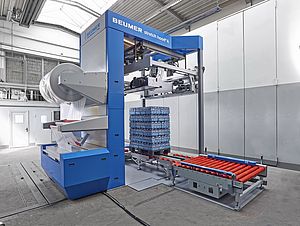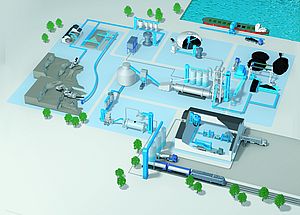In many industrial processes – as for example in the cement industry – the regularity of the raw materials used plays an important role in the manufacture of products. This uniform consistency is ensured through blending beds located within the storage yard.
Be it houses, bridges or tunnels: cement is the material that holds everything together. However, a bag of this material has already come a long way before it arrives at the building site. When the component raw materials are mined and transformed into cement at the cement plant, they pass through many different stages. The most important raw materials for cement production are limestone, clay and marl, extracted from quarries. Wheel loaders and trucks transport the raw materials to the crushing facilities. There, the rocks are crushed to the approximate size of road gravel. These rocks then arrive at the cement works via miles long belt conveyors.
A consistent quality must be ensured so that the producers can further process the material to high-quality cement – fluctuations in the material characteristics must not occur. Therefore, a belt conveyor transports the individual raw materials to the blending beds. These storage location systems mix and homogenise the raw materials.
The blending beds by Beumer are customised according to customer’s requirements, in either longitudinal or circular stockpile designs. Depending on the field of application, the blending beds can be used at extreme ambient temperatures, for very high entry conveying capacities, as well as for the highest degree of homogenisation required. The environmental impacts are very low as minimal noise and dust occurs during operation. Blending beds can be set up both outdoors and indoors.
The stacker and the bridge scraper are the basis for a blending bed. If they are perfectly designed, the user will obtain an optimum blending effect. The stackers can be of fixed or mobile types, depending on the requirement. In case of circular stockpiles the stackers are mounted onto a column and with a longitudinal blending bed, they are mounted on rails. The stackers are designed as fixed, raisable and pivotable booms with conveying capacities of up to 4,000 tons per hour. The choice of the right system depends on different factors, as for example, the shape and size of the stockpile, the material, the throughput and the desired mobility.
The bridge scraper homogenises the material. It has a mobile rake on each side. The material is removed in layers by stroking the face of the stockpile with the rake. The scraper blades move the bulk material towards the belt conveyor which runs parallel to the stockpile. Bridge scrapers are not only robust, but they also transport the bulk material so that the product is handled gently. Their continuous and comparably simple working motions allow for a fully automated operation and ensure a constant and steady flow of the bulk material.
In the past, the Beumer team has completed remarkable projects in this field. One such example is an installation of a bridge scraper in Russia, which works at an ambient temperature as low as -40 degrees Celsius. The rail width is 34m and this bridge scraper is designed for a conveying capacity of 500 tons per hour. Furthermore, the company has developed a stacker for coal mining, which is operated at ambient temperatures of -20ºC. This boom has a length of 41m and the belt width measures 1.6m. It transports 2,250 tons of bulk material per hour. Anoterh example is the engineering of a bridge scraper with a rail width of 55m that conveys 1,100 tons of coal per hour.



















